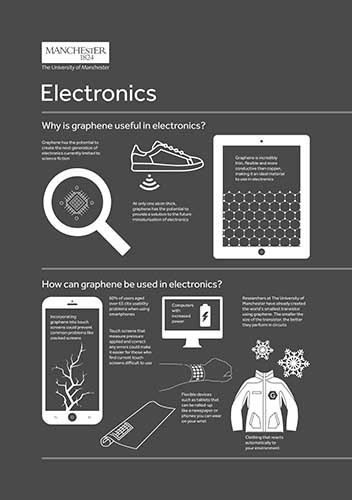
Electronics
Graphene has the potential to create the next-generation of electronics currently limited to sci-fi. Faster transistors; semiconductors; bendable phones and other electronics.
Graphene electronics
Graphene can be used as a coating to improve current touch screens for phones and tablets. It can also be used to make the circuitry for our computers, making them incredibly fast. These are just two examples of how graphene can enhance today's devices. Graphene can also spark the next-generation of electronics.
Wearable technology
Graphene could see a smart phone which you could wear on your wrist or a tablet you could roll up like a newspaper. Flexible, wearable electronics take advantage of graphene's mechanical properties as well as its conductivity. Indium-tin oxide is currently used for touch screens as it conducts well but it is brittle.
Graphene Transistors
Researchers at The University of Manchester have already created the world's smallest transistor using graphene. The smaller the size of the transistor, the better they perform within circuits. The fundamental challenge facing the electronics industry in the next 20 years is the further miniaturisation of technology.
Graphene Semiconductors
Graphene's unique properties of thinness and conductivity have led to global research into its applications as a semiconductor. At just one atom thick and with the ability to conduct electricity at room temperature, graphene semiconductors could replace existing technology for computer chips. Research has already shown that graphene chips are much faster than existing ones made from silicon.
Related links
- Nature Materials letter: Light-emitting diodes by band-structure engineering in van der Waals heterostructures

